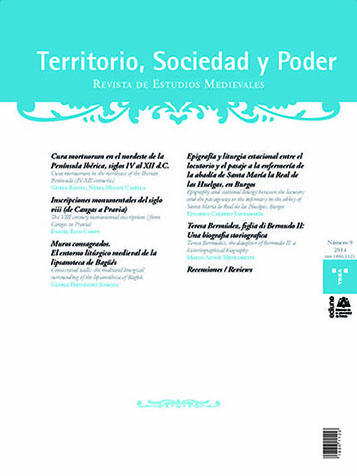Resumen
Resumen: El monasterio de Las Huelgas de Burgos conserva un conjunto de epígrafes en los dos pasos de comunicación entre el claustro de San Fernando y la zona de Claustrillas. Recogen fragmentos litúrgicos de los Salmos y de la Salve y el Oficio de completas que, por una parte, ponen de manifiesto el uso de ambos pasos como estaciones en la liturgia procesional de las monjas y, por otra, son un argumento más para interpretar el conjunto tardorrománico de las Claustrillas como la enfermería y el palacio abacial, siguiendo la topografía habitual de los monasterios cistercienses.
Palabras clave: Huelgas. Burgos. Císter. Epigrafía. Liturgia. Enfermería. Palacio abacial.
Abstract: Cistercian monasteries figure in the popular imagination as embodiments of an austerely pure monastic spirituality. In turn, the interpretation of the physical remains of these monasteries focuses on the foundational moment, often identifying one of the small chapels located around the periphery of the monastic enclosure as the oratory founded by the original community, used until construction of the church reached a sufficiently advanced stage. In some cases, these popular traditions have a basis in reality, as we see in the case of the chapel of Santa Mariaa- Velha in Alcobaça (Portugal). This chapel, located some hundred metres from the monastery, temporarily served as the monastic church during the construction of the new abbey church, as a series of medieval inscriptions at the site tell us. In other cases, these chapels, usually located in the eastern portion of the monastic complex, pertained to the original layout of the monastery, serving such functions as the infirmary or abbot’s chapel. These cult spaces formed part of the larger liturgical setting of the monastic complex, being the site of occasional masses. Monastic infirmaries were generally located to the east of the main cloister, near the abbot’s palace (where such a structure existed), which suggests that these chapels were shared between these two entities. The monastery of Las Huelgas in Burgos conserves a collection of inscriptions located in the corridors that communicated between the cloister of San Fernando and the area known as Las Claustrillas. These inscriptions include liturgical fragments of the Psalms, the Salve Regina, and the Office of Compline. On the one hand, these inscriptions underscore the liturgical use of these transitional spaces in the nuns’ processions. On the other hand, they constitute another argument in favour of interpreting the late Romanesque complex of Las Claustrillas as an infirmary and abbot’s palace, as we see in other Cistercian monasteries.
Keywords: Huelgas. Burgos. Cistercians. Epigraphy. Liturgy. Infirmary. Abbesses Palace.

